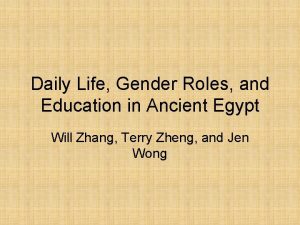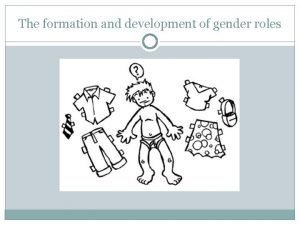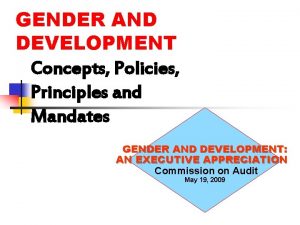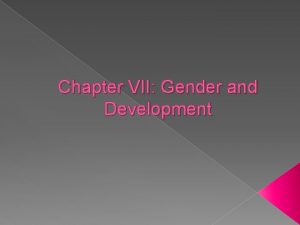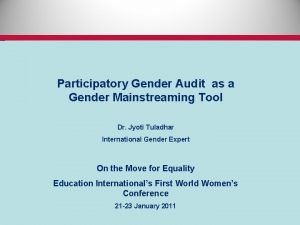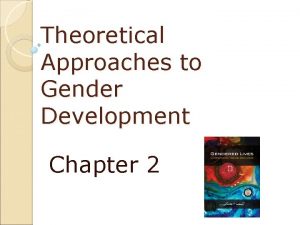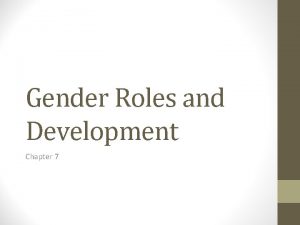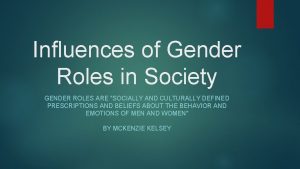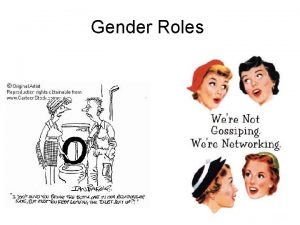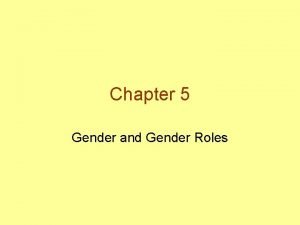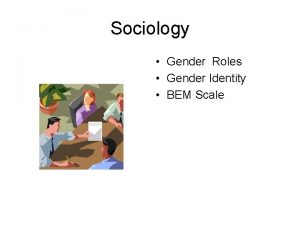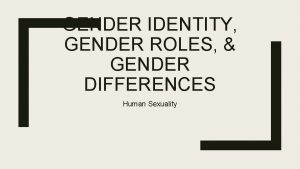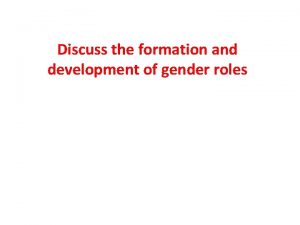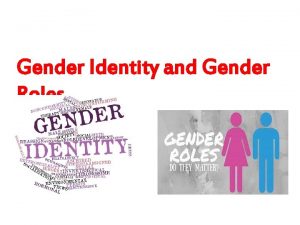The formation and development of gender roles DefinitionsDistinctions






















- Slides: 22

The formation and development of gender roles

Definitions/Distinctions Sex refers to the biological facts about us (anatomy and functioning) Gender is what culture makes out of the raw material of biological sex Gender typing The process by which children acquire the values, motives, and behaviors viewed as appropriate for males and females within a culture Gender identity refers to how we classify ourselves and others Gender Roles refer to the behaviors, attitudes, values, beliefs, expectations society deems appropriate on the basis of biological sex Gender constancy age which children recognize that gender is set and therefore not controlled by other factors such as clothing or hairstyle

Are male and female brains different? v Destruction of small parts of rats’ hypothalami resulted in new-born males behaving as though they were female (Dorner, 1976) v Hemispheric specialization – when males perform spatial tasks, there’s greater electrical activity in the right hemisphere (Bryden and Saxby, 1985) v Baron-Cohen 2003 states that the female brain is hardwired for emphathy (baby girls as young as 12 months respond more emphatically to others’ distress, show more sad looks, and express comforting vocalizations v Emphathizing-Systemizing (E-S) theory of brain differentiation.

Case Study: Biological determinants of gender identity Case Study: The Batista Family (Imperato-Mc. Ginley et al. , 1974) There are ten children in the Batista family. Four of the songs have changed from being born and growing up as girls into muscular men (they were born with normal female genitalia and body shape, but when they were 12, their vaginas healed over, two testicles descended, and they grew full-size penises. Change occurred because of the flood of testosterone which occurred at puberty to give the normal male appearance Key Note – Their ability to adopt a male gender identity and gender role suggests that their testosterone had programmed masculinity into their brains. This study is indicative of the nature view of gender identity as being programmed before birth

Case Study – David Reimer (aka John, Joan, Brenda) Read the case study on page 210. Answer the three questions in your notes in the Be a thinker box. Pay special attention to researcher bias and demand characteristics.

Biosocial Theory of Gender Development (Money and Ehrhardt, 1972) Dr. John Money – interaction ü We are treated through gender stereotypes according to our genetically assigned sexual physiology. ü Children are gender neutral at birth and gender identity is the result of socialization. ü Worked with intersex children and believed that gender could be assigned.

The Story of X �Do we treat babies fairly in regards to being a boy or a girl? �What do we do when we don’t know?

How is gender assigned socially? Baby “X” Experiments (Smith and Lloyd, 1978) • One baby was dressed in neutral clothing and given either a boy name, a girl name, or a neutral name. When asked regarding gender, the researchers placed the baby into three categories: male, female, or unknown

Social/Cultural Influences on Gender typing �How much influence does culture & social expectations have on the development of gender? �I’m glad I’m a Boy! �Toddlers begin to identify with a gender at 19 mos. ( �Kids age 3 -6 have very strong feelings about the difference between boys & girls �Parents tend to put more pressure on boys to conform to their gender role than they do girls

Evolutionary theory �Gender has evolved over the course of human development as part of our broader adaptation to the environment (Lumsden and Wilson, 1983). �Different roles have developed between males and females because physical traits facilitate each gender in their various roles (i. e. labor and reproduction) MEN Women Physical strength Child-bearing Larger lung capacity Milk-producing Aggression Verbal ability Systemizing Naturally empathetic

Social Learning Theory üInclusion of biosocial (Gender X) views üIncorporates observational learning and reinforcement üBy observing others and then imitating that behavior, children receive reinforcement from significant others for “sex-appropriate behavior” (Bandura 1977) üReinforcement coincides with biosocial stereotypes of behavior to produce learned sex -typed behavior üParents not only reinforcers – media, schools üCritique – children show a preference of modeling the behavior of those with whom they have most contact (Hetherington, 1967)

SLT support • Sroufe et al. (1993) observed that kids (10 -11 years) who did not behave in a genderstereotyped way were the least popular. • Gunter (1986) found that children categorized as heavy TV viewers hold stronger stereotyped Fagot (1985) – observational beliefs than lighter viewers. study. Found that boys (21 -25 months) made fun of boys who played with dolls or with girls

Findings not in support of SLT Gunter and Mc. Aleer (1997) • Children are not passive receptors of TV content. • Children selectively respond to particular characters and events. • Personal dispositions affect change in perception, memory, and understanding. Quiery (1998) • Fathers’ adoption of either sex-typed or egalitarian attitudes have been found to correlate with four yrolds’ perceptions of sexroles

Gender Schema Theory (GSPT) �Bem (1985) and Martin (1991) Gender identity alone can provide children with sufficient motivation to assume sex-typed behavior patterns �Steps Development allows for schema to be formed Observation (SLT) provides for children to develop selfconcept in response to external perceptions of others Self-concept is mixed with cultural schemas for comparison Self-esteem linked with measuring up to gender schema

Gender Schema Theory New Boys and New Girl Toys Martin and Halvorson (1983) � Boys and girls (age 5 -6) � Presented pictures of males and females in activities either in line with gender role schemas or inconsistent with gender role schemas � Children later tested on memory of images presented the week before � Distortions evident in memories of models exhibiting behaviors outside of gender schema

�Strength – Child will seek out Strengths and limitations of Gender Schema Theory of Gender Identity stimuli that supports (fits) the schemas they have created for self and others. The world is then divided into masculine/feminine labels through which attention is given according to observations made through social learning, thus steering the child to more masculine/feminine behaviors dependent upon the child’s selfperception.

Limitations of Gender Schema Theory of Gender Identity üIt’s not possible to explain how and why gender schemas develop/form (same criticism as schema theory) üToo much focus on individual and not enough emphasis on social and cultural factors üKey Questions – üTo what extent would culture affect schema development and/or differences between cultures regarding schema-appropriate behavior? üIs there a universal norm for masculine/feminine? üIf in fact we believe that schema development is responsible for gender identity, do we eliminate all biological precursors/predeterminants?

Differences between SLT and GST

Margaret Mead – A changed woman Arapesh, Mundugumor, and the Tchambuli tribes of New Guinea (1935) ØBelieved traits (masc/fem) were completely unrelated to biological sex ØJust as clothing, manner, and headdress aren’t determined by sex, so temperament and gender roles aren’t biologically determined either. ØUsed the cultural differences among tribes of New Guinea as evidence of her views ØArgued that human behavior is not determined by genes alone but that it is a product of beliefs and values within culture. Samoa, Manus, Iatmul, and Bali (1949) After 14 years of research (and having a baby), Mead came to the conclusion that women were naturally more nurturing than men (motherhood as a biological inclination). Fatherhood, according to Mead, was a social invention which is why there are distinct differences in male behavior between cultures.

Cultural Universals within Gender Identity development Aggression Nurturing Support – There are no known societies in which the female does the fighting in warfare. Rebuttal – Malinowski (1929) ü Studied Trobriand Islanders ü In order to support their tribe’s reputation for virility, groups of women would catch a man from another tribe, brutally rape him, and then boast about their achievement Nurturing behavior was often excluded in the work of early researchers (confirmation bias) by not listing certain “nurturing” behaviors as such: ü Provision of food ü Providing safety

Berdache – a biological male who simply chooses not to follow the ideal role of warrior but instead becomes the wife of a warrior. Cultural norms dictate what in fact is normal within society. Apply the evidence found within Native American, Alentian, and Madagascar tribes to the notion of gender role development.

Works Cited Crane, J. , & Hannibal, J. (2009). IB Diploma Programme Psychology Course Companion. Oxford: Oxford University Press. Gross, R. (2009). Psychology: The Science of Mind and Behaviour (5 ed. ). Dubai: Hodder Arnold. *note – creator recognizes that the pictures remain uncited and wishes to give credit to the many websites visited to acquire them.
 Gender-role development
Gender-role development Strategic gender needs and practical gender needs
Strategic gender needs and practical gender needs Gender roles in snow white and the seven dwarfs
Gender roles in snow white and the seven dwarfs Gender issue in school
Gender issue in school Is there any bias in gender roles based on the excerpt
Is there any bias in gender roles based on the excerpt Ancient gender roles
Ancient gender roles Contemporary gender roles
Contemporary gender roles Gender inequality quiz
Gender inequality quiz Gender representation in casablanca
Gender representation in casablanca What does the bible say about gender roles
What does the bible say about gender roles Gender roles theory
Gender roles theory Indus valley gender roles
Indus valley gender roles Qin dynasty gender roles
Qin dynasty gender roles David reimer
David reimer A thousand splendid suns gender roles quotes
A thousand splendid suns gender roles quotes Gad objectives
Gad objectives Objectives of gender and development
Objectives of gender and development Gender and development
Gender and development Sample lesson plan in gender and development
Sample lesson plan in gender and development Formation initiale vs formation continue
Formation initiale vs formation continue Theoretical approaches to gender development
Theoretical approaches to gender development Hát kết hợp bộ gõ cơ thể
Hát kết hợp bộ gõ cơ thể Lp html
Lp html





